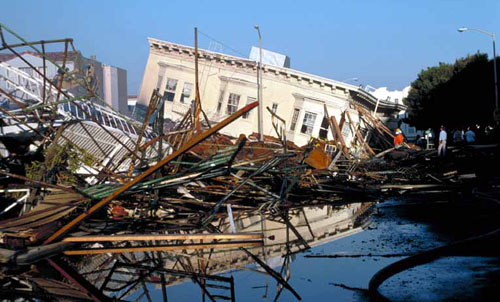By Dr. Friedemann Freund; Carl Sagan Center for the Study of Life in the Universe, SETI Institute, and Gail Jacobs
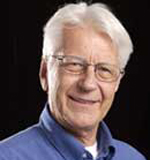 Friedemann Freund doesn't shrink from taking on the really big problems. His research has elucidated such important phenomena as the fact that rocks under stress behave like batteries that can produce currents deep within the crust of the Earth. These are not piddling electron flows, either - the currents could be as large as millions of amperes, sufficient to be measured above ground, and perhaps even from orbit. Understanding and exploiting this phenomenon could lead to a dramatic breakthrough in earthquake forecasting.
Friedemann Freund doesn't shrink from taking on the really big problems. His research has elucidated such important phenomena as the fact that rocks under stress behave like batteries that can produce currents deep within the crust of the Earth. These are not piddling electron flows, either - the currents could be as large as millions of amperes, sufficient to be measured above ground, and perhaps even from orbit. Understanding and exploiting this phenomenon could lead to a dramatic breakthrough in earthquake forecasting.
Click on images for larger view
Friedemann, how did the science of earthquake forecasting attract your attention?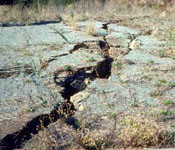 I became active in earthquake research approximately 15 years ago. What many find surprising is I came to study earthquakes from the field of basic physics - I wanted to understand defects in minerals that affect the physical properties of rocks when put under stress. Of course, our very tectonically active, dynamic planet puts rocks under enormous stresses all the time. Eventually, these rocks rupture and generate huge shock waves that can bring down buildings or generate tsunamis that can run back and forth across an entire ocean several times. It is mind boggling to realize a magnitude 9 earthquake releases the energy equivalent to several million atomic bombs of the Hiroshima class. Photo to the left is an extensional crack taken in the Santa Cruz Mountains, California, on October 17, 1989. Credit: R.J. McLaughlin, U.S. Geological Survey
I became active in earthquake research approximately 15 years ago. What many find surprising is I came to study earthquakes from the field of basic physics - I wanted to understand defects in minerals that affect the physical properties of rocks when put under stress. Of course, our very tectonically active, dynamic planet puts rocks under enormous stresses all the time. Eventually, these rocks rupture and generate huge shock waves that can bring down buildings or generate tsunamis that can run back and forth across an entire ocean several times. It is mind boggling to realize a magnitude 9 earthquake releases the energy equivalent to several million atomic bombs of the Hiroshima class. Photo to the left is an extensional crack taken in the Santa Cruz Mountains, California, on October 17, 1989. Credit: R.J. McLaughlin, U.S. Geological Survey
The conventional seismological community is unable to derive early warnings for even the large magnitude earthquakes, such as the recent quake that devastated parts of Japan or the 2004 Indian Ocean earthquake off the west coast of Sumatra that produced a killer tsunami. Through my work, I hope to help build an understanding of the very subtle signals generated when stresses are building up deep in the Earth to the level where rocks will eventually rupture.
How did your research into mineral defects lead you to the study of pre-earthquake signals?
I became interested in certain mineral defects many years ago while living in Germany. I chose the simplest oxide material one could attain, which was magnesium oxide. My colleagues were skeptical of this area of study, thinking there was nothing left to find. But my work led me to a family of defects, which everybody else had overlooked or misinterpreted as "dirt" or some unspecified form of contamination. I spent the next 20 years characterizing these defects with every physical technique available. I discovered one of the characteristic features of these defects was that, when activated, they would change the electrical conductivity, by 8 orders of magnitude. An enormous change.
After working in this area a number of years, turning more toward studying rocks, I recalled my old studies on the magnesium oxide crystals. They had generated electricity when I "tickled" them. By the mid-1990s, I knew that minerals in common rocks have the same type of defects. It occurred to me that if I mechanically stressed those rocks, I might be able to generate electricity.
This idea turned out to be correct but it took another 10 years before I had time to invent an experiment that has since become a benchmark experiment. Working with two post-docs at NASA Ames, I was able to demonstrate in 2006 that when we apply moderate stress to one end of a block of granite about 20 feet in length, we could draw an electric current from the other end. In addition, based upon a theoretical paper I had published in the mid-1980s, we showed that air molecules become massively ionized at the rock surface and that small sparks are flying off the corners and edges due to the firing of corona discharges.
Are your findings currently being used in the field to detect unusual ionization levels in the atmosphere?
I've been working with Tom Bleier, who leads Quakefinder, the humanitarian R&D division of Stellar Solutions. Tom has now installed air conductivity sensors along California's San Andreas Fault. When there has been a moderate or big earthquake not far from one of his sensor stations, he has indeed recorded a very large increase in air conductivity. When we saw this effect for the first time, we were very pleased even though our sensor was overwhelmed by the amount of ionization. This air ionization at the ground level and the upward expansion of the heavily ion-laden air, probably up to the stratosphere, is what causes distinct reactions in the ionosphere some 200-300 km above us. These are very complex processes, widely reported in the scientific literature as potential pre-earthquake indicators - fascinating for us to begin understanding how these processes work. I'm pleased to see this work receiving press coverage, including news reports in Los Angeles and the San Francisco Bay Area.
What is the coolest thing about your project?
The sheer scope of the work is energizing! Earthquakes are only one of the many aspects that have come out of my work. Even though I plunged into this earthquake arena and some people now call me the earthquake guy, this work is actually only an entry into an even wider area of research.
How is your research expanding in scope?
In reading a variety of seemingly unrelated reports, I began to wonder if the defects I had seen in the minerals 25 years prior could be responsible for the signals people were reporting from the natural environment prior to earthquakes. To me, the answer very quickly became Yes! That seemed to be an intriguing avenue to follow.
In early June 2011, I gave a talk at a brain mapping conference in San Francisco, California, in which I pointed out a very interesting phenomenon. The ionosphere that wraps around the globe has a standing wave that is constantly fed by lighting strikes on the surface of the Earth. Every lighting bolt that hits the Earth emits a broad electromagnetic radiation from very high frequencies that you can actually hear. In the old radios, you could hear the crackle of lightening strikes.
But there is also a very low frequency component; and one component in the low frequency, around 8 Hz, is the frequency that a wave takes to travel in one single oscillation around the entire Earth and reconnect. I became interested in the influence these extremely low frequency electromagnetic waves might have on living organisms. It turns out our brain emits radiation at 8 Hz and 4 Hz. Even the brains of little animals, such as mice, emit 4 Hz of electromagnetic radiation.
Prior to an earthquake, the earth sends out bursts of low and extremely low frequencies that cover the entire spectrum around 8 Hz from millihertz to 100 Hz. These electric waves come from the belly of the earth. There are some very interesting studies that link psychological and physiological phenomena in humans and animals to the approach of big earthquakes exactly at the same time when these electromagnetic waves are emitted.
What are some examples of psychological or physiological phenomena exhibited prior to an earthquake?
Evidence is mounting that ultra low frequency and extremely low frequency radiation emitted in the natural environment can have profound effects on human and animal health and behavior prior to an earthquake. An excellent paper has been written by Dr. A. Shitov, a professor in Southern Siberia. He characterized a number of incidents that occurred prior to the 2003 magnitude 7.5 Chuya earthquake, a remote area in Siberia. One of the aspects he looked at was medical records. Dr. Shitov was able to show that about two weeks before this earthquake, there was an unusual increase in the number of people seeking medical help. The complaints of those who flocked to hospital emergency rooms before the earthquake were related to neurological conditions - hypertension, vegetative vascular dystonia, epilepsy - while other conditions such as acute respiratory infections and gastro enteric diseases, which are due to poor air quality and drinking water pollution, showed up after the quake.
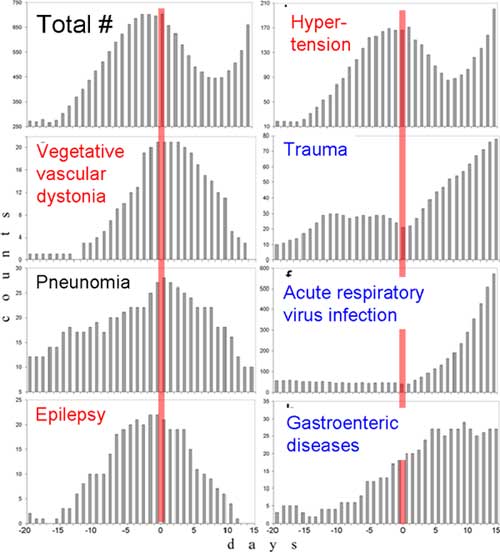
Emergency visits prior to the Magnitude 7.5 Chuya earthquake in Siberia. September 27, 2003.
A. Shitov, 2010
Another example of interesting pre-earthquake behavior came about through pure chance. In the spring of 2008, a group of medical doctors at the University of Chengdu in Sichuan, China, were monitoring the circadian rhythm of laboratory mice. On May 12, 2008, in the midst of their experiment, the devastating magnitude 8.0 Wenchuan earthquake occurred less than 100 kilometers from the university. The researchers continued their experiment but then found out that three to four days before the earthquake, the circadian rhythm of the mice had become completely random. This continued for a few days after the earthquake, until the animals' behavior returned to a normal pattern. A friend from China sent me the electromagnetic wave spectrum recorded at the same university. It showed a large extremely low frequency electromagnetic emission two or three days before the Wenchuan earthquake - at the same time the mice exhibited their strikingly abnormal behavior.
In a third example from 2009, a Ph.D. biology student from The Open University in England was in Italy continuing her third year of studying toads and their mating behavior. Suddenly the toads disappeared from the lake, which was the study area. When the student couldn't locate the toads, she became worried as this was extremely unusual behavior. Then the deadly 6.3 magnitude earthquake hit the heavily damaged the town of L'Aquila, Italy, approximately 70 kilometers from the lake. Three days later the toads returned.
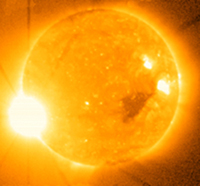 Strange and interesting things are observed before major earthquakes. I find this area of study a wonderful challenge in which to understand the complexities of the world. It's fascinating to think these occurrences are driven by the sun and are influenced by processes that originate in our closest star. We have a diurnal pattern of a distribution of earthquakes controlled by a current in the ionosphere, which is controlled by the activity on the sun. When we move into a new cycle of solar activity, such as we are now entering, the currents in the ionosphere will have a higher chance of triggering earthquakes in the earth's crust. If you look at 100 or so years of seismic activity records from around the world, you will see a clear pattern that the number of earthquakes follows the solar activity. I want to understand the details surrounding this fact. Image to left: The X9-class solar flare of Dec. 5, 2006, observed by the Solar X-Ray Imager aboard NOAA's GOES-13 satellite. Credit: NOAA's Space Weather Prediction Center
Strange and interesting things are observed before major earthquakes. I find this area of study a wonderful challenge in which to understand the complexities of the world. It's fascinating to think these occurrences are driven by the sun and are influenced by processes that originate in our closest star. We have a diurnal pattern of a distribution of earthquakes controlled by a current in the ionosphere, which is controlled by the activity on the sun. When we move into a new cycle of solar activity, such as we are now entering, the currents in the ionosphere will have a higher chance of triggering earthquakes in the earth's crust. If you look at 100 or so years of seismic activity records from around the world, you will see a clear pattern that the number of earthquakes follows the solar activity. I want to understand the details surrounding this fact. Image to left: The X9-class solar flare of Dec. 5, 2006, observed by the Solar X-Ray Imager aboard NOAA's GOES-13 satellite. Credit: NOAA's Space Weather Prediction Center
Why should the general public care about your research?
There's no doubt seismologists have done wonderful work. They look at the number of earthquakes, details of past earthquakes, and then they construct elaborate statistical models when the next earthquake will happen. But they can't "predict" earthquakes. That's where the 30-year uncertainty comes in that is reflected in insurance policies.
I don't want to look backwards at past earthquakes and predict future earthquakes statistically. I want to train my eyes or my instruments to understand the earthquakes as they happen. As the stress is building up deep in the earth 10, 20, 35 kilometers below the surface of the earth, can we pick up and understand the signals that are detectable at the surface? Since these signals range from animal behavior to ionospheric perturbations and everything in between, it is important to understand how the basic physics is related. If we can show - and I think we can - how atmospheric phenomena and phenomena in the biologic world, such as animal behavior, are linked to ionospheric perturbations, we can then use this to forecast conditions under which earthquakes are likely to occur.
Collapsed building and burned area in San Francisco as a result of the October 19, 1989 Loma Prieta earthquake. Credit: C.E. Meyer, U.S. Geological Survey
While we can't predict earthquakes, we can issue an alert stating, "Stresses seem to be building up deep in the earth's crust at a particular fault and if these stresses reach a certain level, there is an increased chance of an earthquake within the next few days." This can have tremendous impact on the public and saving lives, instead of being unprepared and having to deal with the aftermath of a massive earthquake.
How has your lifelong study into the physics of Earth influenced your thoughts on the possibility of life on other planets?
Wherever in the universe there is a planet with land and liquid water and an active weathering system, I predict that this planet will slowly but inextricably become oxidized. Even without life and without photosynthesis this planet will acquire oxygen in its atmosphere. Carl Sagan's proposal of the "pale blue dot" being a symbol of life in the "blackness of space" is a beautiful metaphor. Life is not necessary to create a pale blue dot, but the same weathering process which injects oxygen will also release organic molecules into the environment, specifically complex molecules such as must have been available on the early earth, forming the basis for self-organization and the origin of life. Image to the right: This is a computer artist's illustration of a giant but remote galaxy string discovered recently. Credit: NASA
My work suggests that wherever planets exist in our galaxy and beyond, which are similar to the earth with a similar weathering system, they will create situations for life to form. If this life self-assembles from the organics released from rocks during the weathering cycle, it will look similar to our own - similar in its overall biochemical foundation. I don't believe in life based on silicon chemistry or on a completely different chemistry. Earth-like planets anywhere will, by necessity, develop both oxygen and primitive life. The slowly but inextricably rising amount of oxygen in the environment will drive the evolution from primitive single-cell organisms like the prokaryotes on earth to more evolved forms of life like the eukaryotes on earth that have learned to not only survive in the presence of oxygen but to thrive in it.
If you had a one-year sabbatical to work on a pet project, what would it be?
I'd like to revisit some ideas I had about 30 years ago. At the time my work had led me to become interested in proton conductivity. I developed a complete semiconductor physics of protons carrying electric currents as they relate to certain chemical processes. I would like to see whether my basic understanding of proton conductivity can be applied to better understand to the functioning of the living cell. Our cells have an amazing capability of transporting protons through the cell membranes. Peter Mitchell who proposed an elaborate but basically "unphysical" mechanism for this transmembrane proton transport received a Nobel Prize. I challenge his idea. If I had six months or a year, or if someone would give me the money to hire a capable young Post-Doc, I'd love to see how far I can take my fundamental understanding of how protons conduct electricity and how they couple to the flow of electrons -- a fascinating project, if only I had the time to do it.
Learn more about Friedemann and his fascinating research in his full interview.
